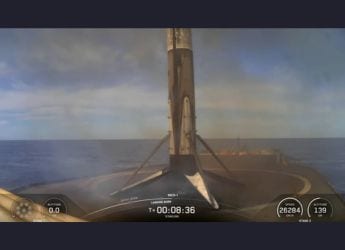- Home
- Science
- Science News
- NASA and NOAA Set to Launch Solar Probes for Space Weather Forecasting
NASA and NOAA Set to Launch Solar Probes for Space Weather Forecasting
NASA and NOAA launch three spacecraft to L1 in Sept. 2025 to monitor the Sun, map the heliosphere, and improve space-weather forecasting.

Photo Credit: NASA
NASA's IMAP, Carruthers, and NOAA's SWFO-L1 launch Sept 2025 to study solar wind at Sun–Earth L1
NASA and NOAA will soon launch three spacecraft (targeted for September 2025) to monitor the Sun's influence. NASA's IMAP (Interstellar Mapping and Acceleration Probe), the Carruthers Geocorona Observatory, and NOAA's SWFO-L1 will ride a SpaceX Falcon 9 to the Sun–Earth L1 point, about a million miles from Earth. Once at L1, the trio will observe the solar wind and space weather from the Sun to the outer heliosphere. Their data will help map our solar “bubble” and give early warning of solar storms that could disrupt satellites, power grids and airline flights..
Charting the Heliosphere and Earth's Exosphere
According to NASA, as a contemporary "celestial cartographer," IMAP spacecraft will investigate the outer boundary of the heliosphere, a massive bubble inflated by the Sun's solar wind. IMAP will advance our knowledge of the reasons our solar system is habitable by mapping the interactions between this bubble and interstellar space, as well as how it protects us from galactic cosmic rays.
The small telescope, the Carruthers Geocorona Observatory, will accompany the journey and record ultraviolet light from the exosphere, Earth's outermost atmosphere. From its position at L1, Carruthers will observe how the Sun affects the exosphere's density, size, and shape, assisting scientists in forecasting how solar storms will affect communications, power, and satellite systems.
NOAA's Space Weather Sentinel
Unlike NASA's science probes, NOAA's SWFO-L1 is an operational satellite dedicated to 24/7 space-weather monitoring. From its perch at L1, it will continuously image the Sun's corona and sample the solar wind to spot eruptions (like coronal mass ejections) well before they reach Earth.
By streaming data in real time to forecasters, SWFO-L1 will give utilities, airlines, satellite operators and astronaut teams extra warning of incoming solar storms that could disrupt power grids, communication networks and satellites
Get your daily dose of tech news, reviews, and insights, in under 80 characters on Gadgets 360 Turbo. Connect with fellow tech lovers on our Forum. Follow us on X, Facebook, WhatsApp, Threads and Google News for instant updates. Catch all the action on our YouTube channel.
Related Stories
- Samsung Galaxy Unpacked 2025
- ChatGPT
- Redmi Note 14 Pro+
- iPhone 16
- Apple Vision Pro
- Oneplus 12
- OnePlus Nord CE 3 Lite 5G
- iPhone 13
- Xiaomi 14 Pro
- Oppo Find N3
- Tecno Spark Go (2023)
- Realme V30
- Best Phones Under 25000
- Samsung Galaxy S24 Series
- Cryptocurrency
- iQoo 12
- Samsung Galaxy S24 Ultra
- Giottus
- Samsung Galaxy Z Flip 5
- Apple 'Scary Fast'
- Housefull 5
- GoPro Hero 12 Black Review
- Invincible Season 2
- JioGlass
- HD Ready TV
- Laptop Under 50000
- Smartwatch Under 10000
- Latest Mobile Phones
- Compare Phones
- Realme P4x 5G
- OnePlus Ace 6T
- Nubia Flip 3
- Nubia Fold
- OPPO A6x 5G
- Samsung Galaxy Z TriFold
- Poco F8 Ultra
- Poco F8 Pro
- Asus ProArt P16
- MacBook Pro 14-inch (M5, 2025)
- Poco Pad M1
- Poco Pad X1
- Just Corseca Skywatch Pro
- Honor Watch X5
- Acerpure Nitro Z Series 100-inch QLED TV
- Samsung 43 Inch LED Ultra HD (4K) Smart TV (UA43UE81AFULXL)
- Asus ROG Ally
- Nintendo Switch Lite
- Haier 1.6 Ton 5 Star Inverter Split AC (HSU19G-MZAID5BN-INV)
- Haier 1.6 Ton 5 Star Inverter Split AC (HSU19G-MZAIM5BN-INV)

















